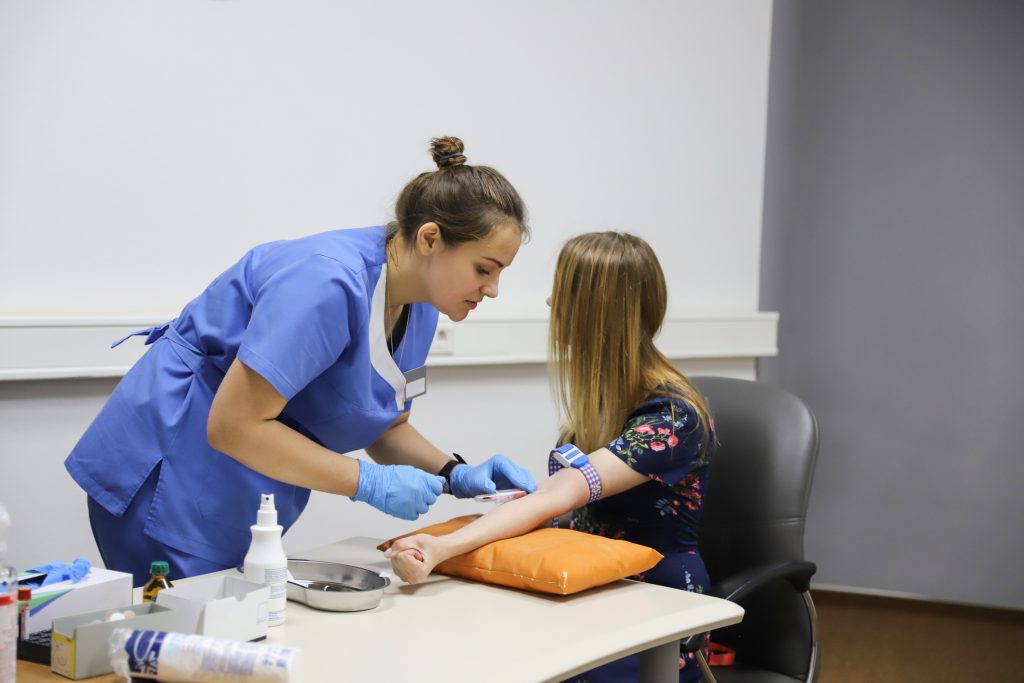The 25-Second Trick For Northeast Medical Institute - New Haven Campus Phlebotomy Course & Cna Class
The 25-Second Trick For Northeast Medical Institute - New Haven Campus Phlebotomy Course & Cna Class
Blog Article
3 Easy Facts About Northeast Medical Institute - New Haven Campus Phlebotomy Course & Cna Class Shown
Table of ContentsSome Of Northeast Medical Institute - New Haven Campus Phlebotomy Course & Cna ClassThe Best Guide To Northeast Medical Institute - New Haven Campus Phlebotomy Course & Cna ClassTop Guidelines Of Northeast Medical Institute - New Haven Campus Phlebotomy Course & Cna ClassSome Known Factual Statements About Northeast Medical Institute - New Haven Campus Phlebotomy Course & Cna Class Northeast Medical Institute - New Haven Campus Phlebotomy Course & Cna Class for BeginnersGet This Report about Northeast Medical Institute - New Haven Campus Phlebotomy Course & Cna Class
The usage of such tools must be come with by various other infection avoidance and control methods, and training in their use.For settings with reduced resources, cost is a motoring factor in purchase of safety-engineered devices - Phlebotomy Classes. Where safety-engineered devices are not offered, proficient use a needle and syringe is appropriate. Unintentional direct exposure and certain info regarding a case must be recorded in a register. Assistance services need to be promoted for those who undergo unintentional direct exposure.
Among the essential markers of top quality of treatment in phlebotomy is the involvement and teamwork of the person; this is mutually advantageous to both the health and wellness employee and the individual. Clear info either composed or verbal must be offered to each person that undertakes phlebotomy. Annex F provides example text for discussing the blood-sampling procedure to an individual. In the blood-sampling room for an outpatient division or center, offer a comfortable reclining couch with an arm rest.
The Ultimate Guide To Northeast Medical Institute - New Haven Campus Phlebotomy Course & Cna Class
Guarantee that the indications for blood tasting are plainly defined, either in a created procedure or in recorded directions (e.g. in a laboratory kind). In all times, follow the strategies for infection avoidance and control provided in Table 2.2. Infection prevention and control practices. Collect all the devices needed for the procedure and location it within secure and easy reach on a tray or cart, making sure that all the items are plainly visible.
Introduce yourself to the individual, and ask the person to specify their complete name. Inspect that the lab type matches the client's identity (i.e. match the patient's details with the laboratory form, to guarantee exact recognition).
Make the individual comfy in a supine setting (if possible). Area a tidy paper or towel under the client's arm. Review the test to be performed (see Annex F) and obtain verbal authorization. The client has a right to refuse a test at any moment prior to the blood tasting, so it is necessary to guarantee that the client has actually comprehended the procedure.
Northeast Medical Institute - New Haven Campus Phlebotomy Course & Cna Class - Truths
Expand the client's arm and evaluate the antecubital fossa or forearm. Locate a blood vessel of a good size that shows up, straight and clear. The representation in Section 2.3, shows typical placements of the vessels, but several variants are feasible. The median cubital capillary exists in between muscular tissues and is generally the most simple to penetrate.
DO NOT put the needle where capillaries are diverting, due to the fact that this raises the chance of a haematoma. The vein should show up without applying the tourniquet. Situating the blood vessel will aid in identifying the right dimension of needle. Use the tourniquet concerning 45 finger widths above the venepuncture site and re-examine the vein.
Specimens from central lines carry a danger of contamination or erroneous lab test outcomes. It is acceptable, however not suitable, to draw blood samplings when initial introducing an in-dwelling venous tool, before connecting you can try these out the cannula to the intravenous liquids.
The Greatest Guide To Northeast Medical Institute - New Haven Campus Phlebotomy Course & Cna Class
Allow the area to dry. Failure to enable sufficient call time increases the danger of contamination. DO NOT touch the cleaned up website; specifically, DO NOT place a finger over the blood vessel to direct the shaft of the exposed needle. It the site is touched, repeat the disinfection. Do venepuncture as follows.
Ask the patient to form a hand so the blood vessels are a lot more famous. Go into the blood vessel swiftly at a 30 level angle or much less, and proceed to present the needle along the vein at the most convenient angle of entry - CNA Training. Once sufficient blood has actually been accumulated, release the tourniquet prior to taking out the needle
Getting The Northeast Medical Institute - New Haven Campus Phlebotomy Course & Cna Class To Work
Withdraw the needle gently and apply mild pressure to the site with a tidy gauze or completely dry cotton-wool ball. Ask the client to hold the gauze or cotton wool in position, with the arm extended and raised. Ask the individual NOT to flex the arm, since doing so triggers a haematoma.

Excitement About Northeast Medical Institute - New Haven Campus Phlebotomy Course & Cna Class
Do not press the syringe plunger due to the fact that extra stress increases the danger of haemolysis. Where feasible, keep the tubes in a rack and relocate the shelf towards you. Inject downwards right into the ideal coloured stopper. DO NOT eliminate the stopper since it will launch the vacuum cleaner. If the example tube does not have a rubber stopper, inject incredibly slowly into the tube as reducing the stress and rate used to transfer the sampling minimizes the danger of haemolysis.

Report this page